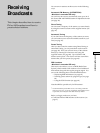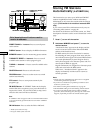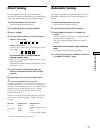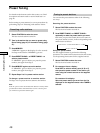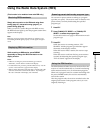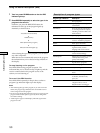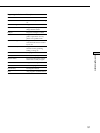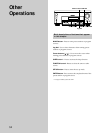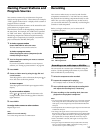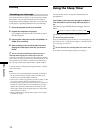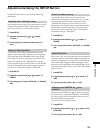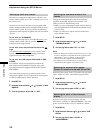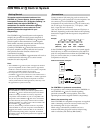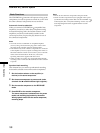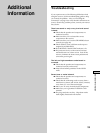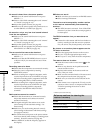
53
Other Operations
A
OFF
A+B
B
–+
0
10
1
9
8
7
2
3
6
5
4
1/u
+–
–+
FUNCTION
Recording
Your receiver makes it easy to record to and from the
components connected to it. You don’t have to connect
the playback and recording components directly to each
other: once you select a program source on the receiver,
you can record and edit as you normally would using the
controls on each component.
Before you begin, make sure you’ve connected all
components properly.
l: Audio signal flow
.: Video signal flow
Recording on an audio tape or MiniDisc
You can record on a cassette tape or MiniDisc using the
receiver. See the operating instructions of your cassette
deck or MD deck if you need help.
1 Select the component to be recorded.
2 Prepare the component for playing.
For example, insert a CD into the CD player.
3 Insert a blank tape or MD into the recording deck
and adjust the recording level, if necessary.
4 Start recording on the recording deck, then start
playback on the playback component.
Notes
• You cannot record a digital audio signal using a component connected
to the analog TAPE OUT or MD/DAT OUT jacks. To record a digital
audio signal, connect a digital component to the DIGITAL MD/DAT
OUT jacks.
• Sound adjustments do not affect the signal output from the TAPE OUT
or MD/DAT OUT jacks.
• The analog audio signals of the currect function is output from the
REC OUT jacks. When you use AUDIO SPLIT to assign a digital audio
input (for example, MD/DAT OPTICAL), the analog audio signals of
the assigned audio (for example, MD/DAT ANALOG) is output.
• When 5.1CH INPUT is selected, audio signals are not output from
REC OUT jacks.
• No signals output from DIGITAL OUT jacks (MD/DAT OPT OUT)
when you select ANALOG DIRECT. The digital circuitry power is
cut off to ensure a superior sound quality.
Naming Preset Stations and
Program Sources
You can enter a name of up to 8 characters for preset
stations and program sources. These names (for example,
“VHS”) appear in the receiver’s display when a station or
program source is selected.
Note that no more than one name can be entered for each
preset station or program source.
This function is useful for distinguishing components of
the same kind. For example, two VCRs can be specified
as “VHS” and “8mm,” respectively. It is also handy for
identifying components connected to jacks meant for
another type of component, for example, a second CD
player connected to the MD/DAT jacks.
1 To index a preset station
Rotate FUNCTION to select the tuner.
The last station you received is tuned in.
To index a program source
Select the program source (component) to be
named, then go to Step 3.
2 Tune in the preset station you want to create an
index name for.
If you are not familiar with how to tune in preset
stations, see “Tuning to preset stations” on page 48.
3 Press NAME.
4 Create an index name by using the jog dial and
cursor buttons:
Turn the jog dial to select a character, then press
to
move the cursor to the next position.
To insert a space
Turn the jog dial until a blank space appears in the
display.
If you’ve made a mistake
Press
or repeatedly until the character to be
changed flashes, then turn the jog dial to select the
right character.
5 Press ENTER.
To assign index names to other stations
Repeat Steps 2 to 5.
Note
(Models of area code CED only)
You cannot change the name of an RDS station.
Playback component
(program source)
.
l
l
.
Recording component
(tape deck, MD deck,
VCR)



